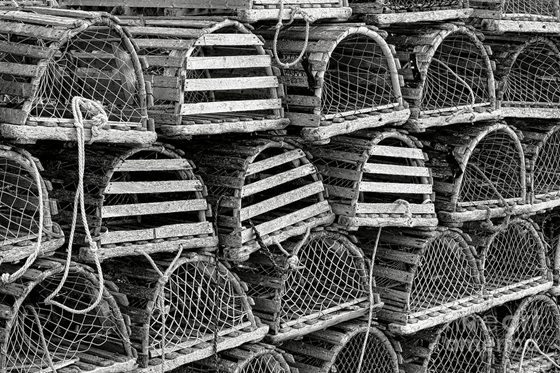\ ˈlan-ˌyap , lan-ˈyap \
: a small gift given to a customer by a merchant at the time of a purchase; broadly : something given or obtained gratuitously or by way of good measure

Maine Lobster Traps, photographed by Olivier Le Queinec
Lobster Traps
Whenever we returned to Maine, either during our summer vacations or to visit family at Christmas, my brother and I would always make our way down to the nearby harbor in Friendship. It was a small port serving both lobstermen and weekend sailors. One thing that always stood out were the massive stacks of lobster traps. I reflected on how the lobster traps were either good or bad depending on who you were: Lobsterman or lobster?
Debt: Is It Good Or Bad?
Similar to lobster traps, we can think of debt from two perspectives. It can be either good or bad, depending on how we use it.
Some people have very strong feelings against debt while others embrace it without hesitation. To address both ends of the spectrum, let's consider some thoughts provided by Kingdom Advisors:
There is a lot here to contemplate, I admit. I also expect some strong reactions either against or in support of these points. To help bring a bit of focus to the topic, let's consider the various types of debt. There are six kinds of borrowing:
The credit card debt can be temporary if you are in the habit of paying off your balance each month. If not, then this is where most Clients find their consumption debt. Food, clothing, and incidentals are poor candidates for debt as they are depreciating assets.
The other five types of loans can serve a very specific, positive purpose. Each person has to consider the full cost of the loan, how pressing their timeline is, and their ability to pay back the loan. If your analysis reveals that the proposed loan doesn't fully fit with your long-term financial plans, it's probably a good idea to avoid the debt.
The overarching concept here is to deeply examine if, and how, the borrowing will be used as a tool to achieve a specific need. As we think back to the lobster trap, are you using debt as a tool or are you possibly being trapped by debt?
Would you like to talk about your overall financial plan and debt management / elimination strategy? Schedule yourself for a meeting so we can develop a highly personalized plan that meets your specific needs..
Laissez les bons temps rouler
Mary's Recipe Corner
Enjoy one of my wife's favorite recipes:
Salad Pizza
A twist on traditional pizza and a Jensen family favorite. Love to hear what you think, should you ever try it.
Pizza crust (enough for a thick, 14 in diameter pizza)
3/4 cup shredded mozzarella (enough to cover the dough)
2 TBSP freshly grated Parmesan
Dressing-
1/4 cup balsamic vinegar
1 TBSP Dijon mustard
1 clove garlic, minced
1 tsp sugar
1/2 tsp dried basil
1/2 tsp dried oregano
2 TBSP olive oil
Salad-
4 cups mixed greens (Spring Mix)
1/2 cup cherry or grape tomatoes sliced in half
1/2 cup thinly sliced red onion
Dressing-
Combine first 6 ingredients and gradually whisk in the olive oil.
Pizza-
Preheat oven to 450 degrees. Spread dough on greased pan. Sprinkle with both cheeses. Bake 10-15 minutes, until crust is golden and cheeses are melted.
Toss salad in dressing. Place salad on the hot cheesy crust, slice, and serve immediately.
Makes 8 servings.
Bon appétit!
For Art's Sake
If you grow up in New Orleans you learn to appreciate art (and food and music and parades, etc.), so it seems appropriate to share a bit of art with our readers.
Jan Steen's "Beware of Luxury", painted in 1663, does a masterful job of capturing some of the many pitfalls of pursuing or achieving, a life of luxury. What is relevant to our message on debt is that luxury is often the goal, and debt can be on the path in achieving it.
Long gone are the days of moralistic teaching through art, but the truest of life's lessons are eternal and always applicable. Consider and reflect.

Beware of Luxury ("In Weelde Siet Toe"), painted by Jan Steen (1626-1679), Kunsthistorisches Museum, Vienna